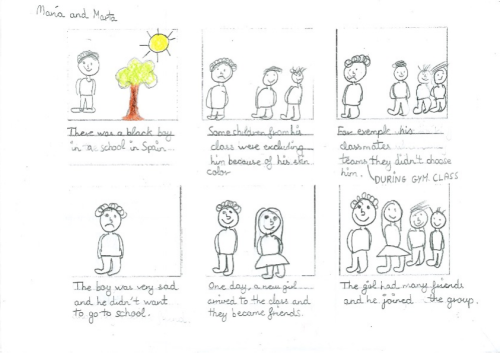2. Your Story
Overview of the module
Modules 1-4 are focused on the Digital Storytelling process as a way to express diversity and to promote inclusion in activities. You will acquire skills in digital storytelling, see examples of stories other students have shared and create your own story on the themes of INCLUSION, WELLBEING AND DIVERSITY. Module 2 looks at the next 2 steps in the Digital Storytelling process: Script writing and storyboarding.
Learning goals
The activities in the module are designed to:
- Learn how to articulate your story into a script
- Different ways of telling a story
- How to create a storyboard
Ice-breaker activity
The Guessing Game
Each student writes a fact about themselves and adds it to a tub. The teacher draws these out one at a time and students guess who the fact relates to.
1.Turn your story idea into a script
You need to take the story idea from the Story Circle and turn it into a script, which will be your voice over for your digital story.
This should be 250 words long so that it takes 1-2 minutes to read through (one hour writing time). The script is your story related to one of the themes of the project: What do those terms, inclusion, wellbeing, diversity, mean to you? Is there an example in your life you can think of where you have felt included, or excluded, where you have felt content, or stressed, where you have felt different to the people around you? What traditions and aspects from your culture (where different or not from your peers) that are important to you and why?
A good way to start a script is setting yourself a question, describe something important to you, or interview yourself on a topic. It can be written like a dialogue (conversation) or narrate your story. You should look at the SOLIS resource library’s many digital story examples to see the unlimited creative ways of telling a story.
- First drafts should be read out to everyone in the group for constructive, positive feedback (10 minutes). Text to speech services, or the teacher, can be used so that everyone is included whether they are comfortable reading their own story or not.
- Feedback should be non-judgemental
- Scripts can be amended after feedback – total length is recommended as 250 words
Video 1 – How did script writing work for you
So the script writing process for me wasn't one that I typically take. I went in with the zero structure. I just kind of took the approach through like kind of like a stream of consciousness.
So I kind of just sat there, thought about my initial ideas and went from there and and because I knew one of my targets was to make it a little bit more personal, more relatable to other people I was bringing in some previous stories...
...Or things that my mum had told me. And I kind of had a suspicion that other people knew about or spoke about also. So I think obviously that inspired me.
And sometimes I find that my writing is better when I spontaneously write rather than going in with a premeditated idea.
So for myself I'm taking the MA Theatre course. I'm not particularly too good at writing scripts, so it was a section that I knew was going to....
...be difficult for me.
So I made sure that I asked for help around the class.
I wrote...
...my story out as it was and classic me...
I did a lot of waffling and the script was far too long, so I asked around for a lot of help and...
...After about 10 minutes...
...my classmates helped me cut it down, changed a couple of the words so it became more of a story rather than just me telling a memory and I left with something that I was extremely proud of.
Script writing for me... I sort of... I struggled with it very much actually because every time I wrote something I ended up not really having a narrative to it.
And so I was there and I used a technique that Mike Wilson taught us and it was...
...he wrote his stuff in verses like it was poetry. You hit a new line every time a new thought...
...comes into your head and after doing that every so often I actually ended up having a proper narrative of a story about winter, which is what I wanted to do mine on...
But I managed to get a story and a narrative about me going to a shop during winter and that was how I kept myself entertained during the dark months.
2. Storyboarding
For examples of storyboarding, please see the SOLIS Digital Storytelling Handbook (page 43 and 44): https://solis-project.eu/resources/
- (one hour storyboarding time)
A storyboard is a detailed plan for you to imagine your story – content, structure and timeframe (up to 2 minutes):

- Basic sketch of each scene matched to your script which will be the voiceover
- Notes of timeframe (a digital story should last 1-2 minutes) and any additional effects that you would like such as music
Important resources
- Link to the SOLIS Digital Storytelling Handbook: https://solis-project.eu/resources/
- Link to digital stories created by other students: https://www.youtube.com/@solisproject6042/playlists
- The SOLIS resource library: https://solis-project.eu/biblioteca/